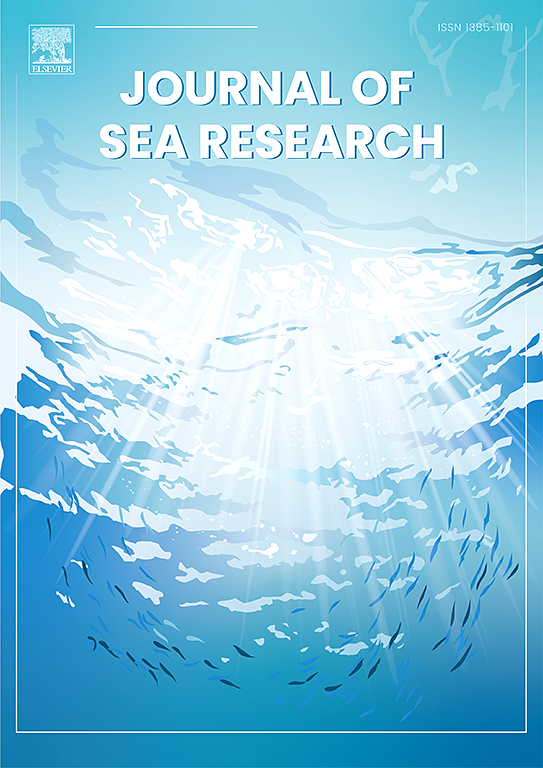基于ADCIRC-SWAN模式耦合模拟的海南地区台风灾害联合风险分析
IF 2.9
4区 地球科学
Q2 MARINE & FRESHWATER BIOLOGY
引用次数: 0
摘要
随着海平面上升和温室效应下台风强度的增加,沿海地区发生强风、风暴潮和海浪等台风相关灾害的风险日益严重。中国海南省毗邻北太平洋西部,容易受到台风灾害的影响。本研究利用Jelesnianski模式强迫高级环流(ADCIRC)-模拟近岸波浪(SWAN)耦合模式构建了65个台风,模拟了台风波浪和风暴潮,评估了它们在20年、50年和100年回归周期下在海南附近的极值。以三亚站为例,进一步结合双因素和三因素进行联合风险分析。模拟的风速(V)、有效波高(SWH)和风暴潮(S)与现场观测值的相对误差小于10%。利用Gumbel函数,海南周边100年回归期V、SWH和S的极值可以超过40 m S−1、15 m和2 m。经过Kolmogorov检验,利用Gumbel-Hougaard Copula函数估计三亚站的二元和三元联合概率分布,并计算不同联合事件的“OR”回归期。在100年极值下,三亚站3个因子的“OR”回归期为48.79年,由于它们之间的相关性,表明它们同时发生的可能性很大。本研究针对海南岛周边复杂地形,利用耦合模型弥补同步观测资料在台风联合风险分析中的局限性。本文章由计算机程序翻译,如有差异,请以英文原文为准。
Joint risk analysis of typhoon hazards based on coupled ADCIRC-SWAN model simulations around Hainan, China
With rising sea level and increasing typhoon intensity under greenhouse warming, risk of typhoon-related hazards, including strong winds, storm surges and waves in coastal regions, is becoming increasingly severe. Hainan province of China, adjacent to the western North Pacific, is vulnerable to typhoon hazards. In this study, we constructed 65 typhoons using the Jelesnianski model to force the Advanced Circulation (ADCIRC)-Simulating Waves Nearshore (SWAN) coupled model and reproduced typhoon waves and surges, then assessed their extreme values around Hainan under 20-, 50-, and 100-year return periods. Taking Sanya station as an example, we further conducted joint risk analysis via considering bivariate and Trivariate hazard factors. The relative errors of modelled wind speed (V), significant wave height (SWH), and storm surge (S) are less than 10 % compared to in-situ observations. Using the Gumbel function, extreme values of V, SWH, and S under the 100-year return period around Hainan province can exceed 40 m s−1, 15 m, and 2 m. After Kolmogorov test, the Gumbel-Hougaard Copula function was used to estimate bivariate and trivariate joint probability distributions at Sanya station and calculate the “OR” return periods of different joint events. The “OR” return period of three factors at the Sanya station under the 100-year extreme value is 48.79 years, indicating a high probability of simultaneous occurrence on account of their correlation. This study focused on the complex topography surrounding Hainan Island and utilized a coupled model to compensate for the limitation of synchronous observational data in typhoon joint risk analysis.
求助全文
通过发布文献求助,成功后即可免费获取论文全文。
去求助
来源期刊

Journal of Sea Research
地学-海洋学
CiteScore
3.20
自引率
5.00%
发文量
86
审稿时长
6-12 weeks
期刊介绍:
The Journal of Sea Research is an international and multidisciplinary periodical on marine research, with an emphasis on the functioning of marine ecosystems in coastal and shelf seas, including intertidal, estuarine and brackish environments. As several subdisciplines add to this aim, manuscripts are welcome from the fields of marine biology, marine chemistry, marine sedimentology and physical oceanography, provided they add to the understanding of ecosystem processes.
 求助内容:
求助内容: 应助结果提醒方式:
应助结果提醒方式:


